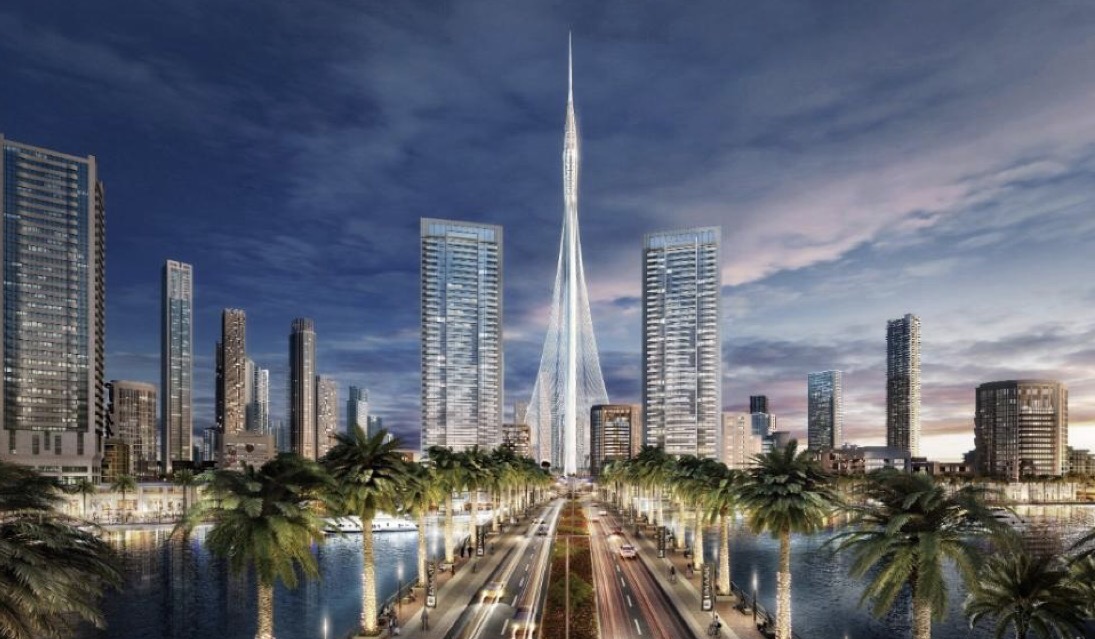Dubai and Saudi Arabia towers in time war to be world’s tallest
The race to the top has just gotten tighter, with two rising mega-towers in the Middle East battling to become the world’s tallest. Construction has now begun on The Tower at Dubai Creek Harbor, a vast waterfront development, with completion scheduled for ahead of Dubai’s Expo 2020 world fair, which kicks off in October that year.
Piercing through a canopy of clouds, The Tower, at 3,045ft (928m), aims to take the title of world’s tallest tower, which the 2,723ft-tall (830m) Burj Khalifa, also in Dubai, has held since 2010. But it’s got competition. The Jeddah Tower, in Saudi Arabia, is also slated to finish in 2020. When completed, this gleaming vertical will be 236ft (72m) taller than Dubai’s creation. If The Tower in Dubai wants the world title, even for a short time, it has to open its doors before the Jeddah Tower.The Tower will be the heart of Dubai Creek Harbour, one of the largest tourist and lifestyle developments in the world stretching across a huge area, namely 6 sqkm. Both of these towers are feats in modern engineering.
The Tower, in Dubai, is being constructed by Emaar, the real estate giant also behind the Burj Khalifa, and will anchor the Dubai Creek development, serving — developers hope — as a magnet for tourists.
Designed by Swiss-Spanish architect Santiago Calatrava Valls, it will feature The Pinnacle Room — an observation point offering 360-degree views of the emirate — and public vertical gardens, while 18 to 20 floors have been reserved for homes, restaurants, shops and a boutique hotel.
If construction runs to schedule, this $1 billion tower will have been thrown up in just three years. The Jeddah Tower, in Saudi Arabia, will have taken a little longer.
Construction on this graceful arrow to the sky began on April 1, 2013, and was originally slated for completion in 2018, but its opening date has already been pushed back twice. Constructing it will require about 5.7 million square feet of concrete and 80,000 tons of steel, according to the Saudi Gazette.
This $1.23 billion USD construction project is, however, already 40 floors off the ground, with 212 left to build — it’s undeniably farther along than the Dubai Tower.
But to think Dubai could finish first is not “as farfetched as it sounds”, according to Jason Gabel, communications manager for the Council on Tall Buildings and Urban Habitat (CTBUH).
“The Dubai project is an observation tower, and therefore won’t require nearly as much lead time as a full-blown skyscraper,” Gabel tells CNN. “2020 is a real possibility for completion.”
Because less than 50% of The Tower’s height is occupied by usable floor space, it is defined by the CTBUH as a “supported tower” rather than a “building”.
This technicality precludes The Tower from achieving the distinction of being the world’s tallest building. Rather, it would be the world’s tallest man-made structure, or tower, until the Jeddah Tower is completed.
Home to more than 65 highrises over 200m tall and counting, Dubai has become synonymous with futuristic skyscrapers, and has been a pioneer of this in the Middle East.
“Historically, no Middle Eastern country has come close to building skyscrapers at the rate and height of the United Arab Emirates (UAE), but notable pockets of high-rise development are occurring in Qatar, Israel, and Saudi Arabia,” says Gabel. “The competitive situation we now see between Saudi Arabia and the UAE very unique.”
Dubai’s lofty intentions debuted in 1979, with the 39-story Dubai World Trade Center. It was the city’s first high rise, and the tallest building in the Middle East.
Subsequent iconic buildings, such as the Burj Khalifa and the Burj Al Arab, have given Dubai global notoriety.

You must be logged in to post a comment.